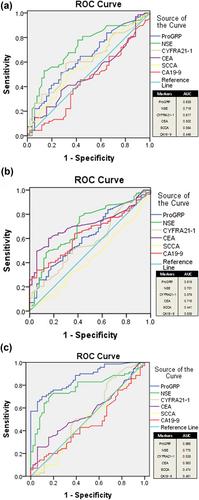Clinical utility of six serum tumor markers for the diagnosis of lung cancer
Abstract
Background
With the increasing prevalence of lung cancer, it has become imperative to identify reliable biomarkers that can aid in early detection and prognosis assessment. Therefore, we sought to investigate the potential utility of six serum tumor markers as diagnostic and prognostic tools for lung cancer patients. By analyzing a large cohort of patients with different stages and subtypes of lung cancer, we hoped to shed light on the predictive value and accuracy of each marker individually, as well as their combined performance. This study should not only provide valuable insights into the biology and pathogenesis of lung cancer but also pave the way for personalized treatment strategies based on individual patient profiles.
Methods
The serum levels of the tumor markers progastrin-releasing peptide (ProGRP), carcinoembryonic antigen (CEA), neuron-specific enolase (NSE), cytokeratin 19 fragment (CYFRA21-1), carbohydrate antigen 19-9 (CA19-9) and squamous cell carcinoma antigen (SCCA) were meticulously assessed in a cohort comprising 324 individuals diagnosed with lung cancer and an additional 51 patients with benign lung disease. The measurements were conducted using cutting-edge techniques such as ELISA, electrochemical luminescence, and chemiluminescence methods. Differences between groups and the impact of these markers on lung cancer diagnosis were analyzed.
Results
The serum levels of ProGRP, NSE, and CEA were significantly higher in lung cancer patients than in patients with benign lung disease (p < 0.01). NSE had the highest sensitivity for squamous cell carcinomas (SC), while CEA had the highest sensitivity for adenocarcinomas (AC). ProGRP and NSE had higher sensitivities than other markers for small cell carcinomas (SCC). Combining the six tumor markers resulted in higher sensitivities for SC (70.6%), AC (77.4%), and SCC (80%) compared with any single test. Receiver operator characteristic analysis showed that ProGRP and NSE had a greater area under the curve (AUC) in SCC (0.886 and 0.775) than SC and AC, while CEA had a higher AUC in AC (0.716), and NSE had a higher AUC than other markers in SC (0.719).
Conclusions
ProGRP and NSE are effective serum tumor markers for SCC, whereas CEA and NSE may aid in the diagnosis of AC and SC. Combining the detection of ProGRP, NSE, CYFRA21-1, CEA, and SCCA significantly improves sensitivity when diagnosing lung cancer.


 求助内容:
求助内容: 应助结果提醒方式:
应助结果提醒方式:


